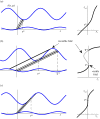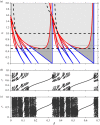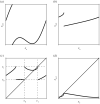Creation of discontinuities in circle maps
- PMID: 35197797
- PMCID: PMC8261204
- DOI: 10.1098/rspa.2020.0872
Creation of discontinuities in circle maps
Abstract
Circle maps frequently arise in mathematical models of physical or biological systems. Motivated by Cherry flows and 'threshold' systems such as integrate and fire neuronal models, models of cardiac arrhythmias, and models of sleep/wake regulation, we consider how structural transitions in circle maps occur. In particular, we describe how maps evolve near the creation of a discontinuity. We show that the natural way to create discontinuities in the maps associated with both threshold systems and Cherry flows results in a singularity in the derivative of the map as the discontinuity is approached from either one or both sides. For the threshold systems, the associated maps have square root singularities and we analyse the generic properties of such maps with gaps, showing how border collisions and saddle-node bifurcations are interspersed. This highlights how the Arnold tongue picture for tongues bordered by saddle-node bifurcations is amended once gaps are present. We also show that a loss of injectivity naturally results in the creation of multiple gaps giving rise to a novel codimension two bifurcation.
Keywords: Cherry flow; bifurcation; circle map; discontinuous map; neuronal models; sleep–wake regulation; threshold model.
© 2021 The Authors.
Figures












References
-
- Bressloff PC, Stark J. 1990. Neuronal dynamics based on discontinuous circle maps. Phys. Lett. A 150, 187-195. (10.1016/0375-9601(90)90119-9) - DOI
-
- Glendinning PA. 1995. Bifurcations and rotation numbers for maps of the circle associated with flows on the torus and models of cardiac arrhythmias. Dyn. Stabil. Syst. 10, 367-386. (10.1080/02681119508806212) - DOI
-
- Borbély AA. 1982. A two process model of sleep regulation. Hum. Neurobiol. 1, 195-204. - PubMed
Associated data
LinkOut - more resources
Full Text Sources

